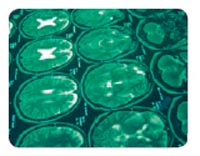

Suddenly you can’t move your leg, your vision is blurred or you have a throbbing headache. The symptoms of a stroke come on instantaneously. But what is crucial for the condition of the patients over the long term are the processes which begin after the stroke. They are what decide how many brain cells will ultimately die. Whether and to what extent these processes occur depends on which signaling pathways are active in the cells. Researchers in the National Genome Research Network (NGFN) are attempting to elucidate these signaling pathways to identify new starting points for new therapy approaches.
Professor Markus Schwaninger and his colleagues at the University of Heidelberg have discovered a component that plays an important role in the processes following a stroke: the protein IKK2 that assumes a central position in an important signal chain. “We suspected that this signaling pathway in the nerve cells activates a self-destruction program,” Markus Schwaninger explains. “But we didn’t know the exact function.”
To clarify this, the scientists bred mice in which the protein IKK2 and thus this signaling pathway in nerve cells could be switched on and off arbitrarily. When IKK2 was absent in the nerve cells or its activity was blocked, considerably fewer nerve cells perished in the aftermath of a stroke. Conversely, when IKK2 was excessively active, the damage in the brain was considerably greater. Moreover, when small, artificial molecules that inhibit IKK2 were administered to the mice, the area affected by the stroke was smaller and considerably fewer nerve cells died.
“The chances are good that IKK2 has a comparable function in human nerve cells,” Markus Schwaninger says. Small molecules that inhibit IKK2 could therefore soon be a new treatment option for stroke patients.




